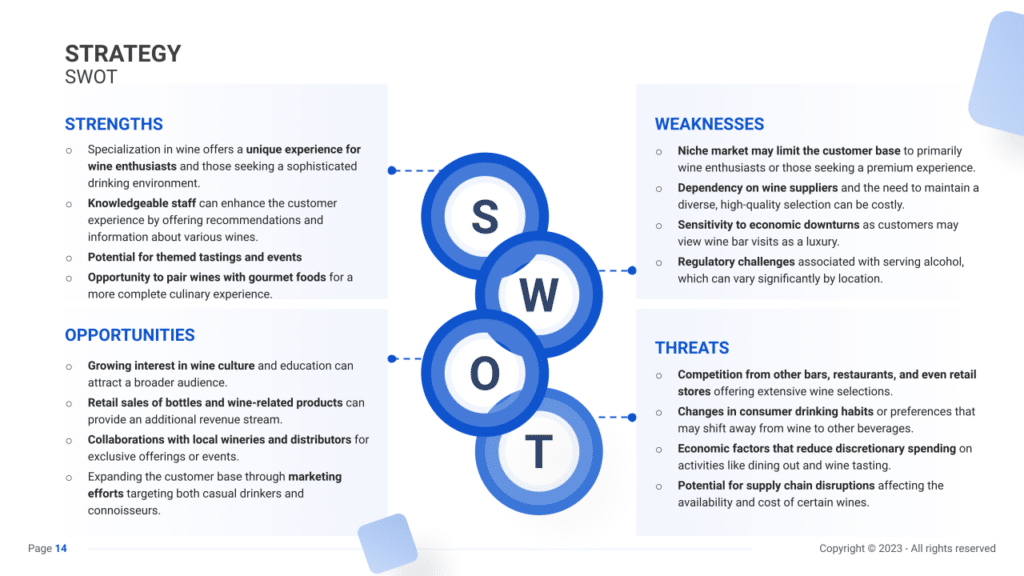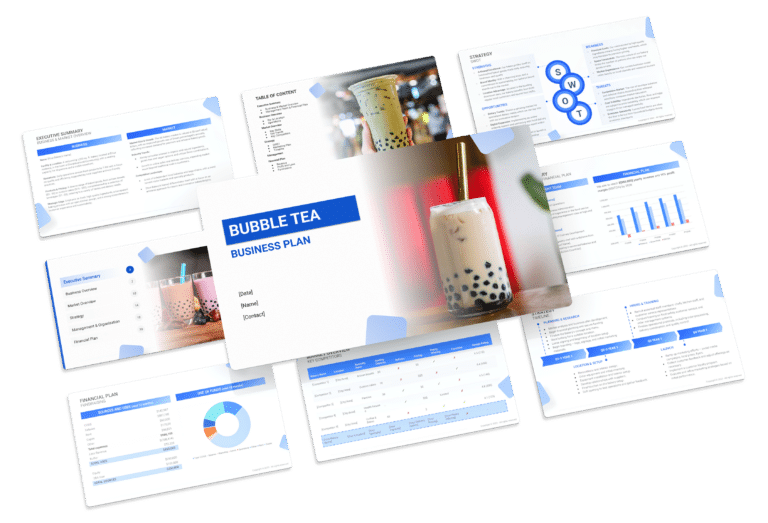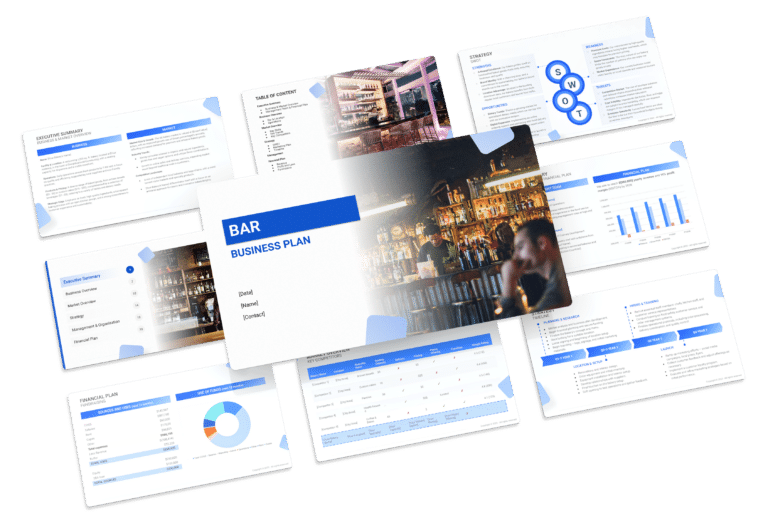How to Prepare a SWOT for a Wine Bar

Conducting a SWOT analysis is pivotal when crafting a business plan for a wine bar. SWOT (Strengths, Weaknesses, Opportunities, Threats) allows owners to assess internal and external factors influencing their venture. While strengths and weaknesses are internal, opportunities and threats are external, shaping the business landscape.
Integrating a SWOT analysis into a wine bar business plan illuminates its current market position and unveils avenues for growth and enhancement. Strengths may encompass a diverse wine selection, knowledgeable staff, and a chic ambiance, while weaknesses could involve limited food options or location challenges.
This article will explore examples of strengths and weaknesses specific to wine bars, providing owners actionable insights for strategic business planning.

Strengths
Discover the inherent strengths that can make your wine bar stand out in a competitive market.
- Diverse Wine Selection: Offering a wide variety of wines appeals to diverse palates, attracting a broad customer base seeking unique and curated experiences.
- Example: Implementing themed tasting events showcasing different wine regions enhances customer exploration and engagement.
- Ambiance and Atmosphere: Creating a cozy and inviting ambiance fosters an enjoyable social experience, encouraging patrons to linger and return for the atmosphere.
- Example: Incorporating live music nights or themed décor can enhance the overall ambiance and attract a trendy clientele.
- Wine Education Initiatives: Providing wine education through staff training or informational materials elevates customer experience and positions your wine bar as an authority.
- Example: Hosting wine tasting classes or offering curated pairing suggestions on the menu can educate and engage customers.
- Local and Global Partnerships: Collaborating with local wineries and international distributors strengthens the supply chain, ensuring a diverse and high-quality wine selection.
- Example: Promoting exclusive partnerships or limited-time offerings can create a sense of exclusivity and attract wine enthusiasts seeking unique experiences.
Weaknesses
Acknowledging weaknesses is essential for mitigating challenges and fostering sustainable growth.
- High Operating Costs: The costs associated with maintaining a wine bar, from inventory to licenses, can strain financial resources, impacting profitability.
- Example: Implementing cost-control measures or negotiating favorable deals with suppliers can alleviate financial pressures.
- Seasonal Demand Fluctuations: The demand for wine bars may fluctuate seasonally, posing challenges in maintaining consistent revenue streams.
- Example: Introducing seasonal promotions or diversifying services, such as hosting private events, can offset the impact of seasonal variations.
- Dependence on External Factors: External factors like economic downturns or changing consumer preferences can influence the wine market, affecting business performance.
- Example: Conducting regular market research and staying agile with offerings ensures adaptability to changing trends and preferences.
- Limited Non-Alcoholic Options: A reliance on alcoholic beverages may limit the customer base, excluding those seeking non-alcoholic alternatives.
- Example: Introducing a diverse range of high-quality non-alcoholic beverages or mocktails can cater to a wider audience and increase inclusivity.
Opportunities
Identifying and seizing opportunities can propel your wine bar to new heights within the hospitality industry.
- Culinary Pairing Experiences: Integrating food and wine pairing experiences can enhance customer satisfaction and attract patrons seeking a complete dining experience.
- Example: Collaborating with local chefs or hosting themed culinary nights can elevate the overall dining and drinking experience.
- Digital Marketing and Social Media Presence: Leveraging digital platforms for marketing and creating an active social media presence can broaden the reach and attract a tech-savvy clientele.
- Example: Running targeted social media campaigns or offering exclusive discounts for online reservations can boost online visibility and customer engagement.
- Wine Club Memberships: Establishing a wine club with exclusive perks and offers for members can cultivate customer loyalty and provide a steady source of revenue.
- Example: Offering members-only events or early access to limited-edition wines can incentivize customer participation in the wine club.
- Collaborations with Event Planners: Partnering with event planners for private gatherings, celebrations, or corporate events can open new revenue streams and expand the clientele.
- Example: Tailoring packages for events like weddings or business functions can position your wine bar as a premium event venue.
Threats
Anticipating and mitigating threats is essential for the sustained success of your wine bar services.
- Stringent Licensing Regulations: Evolving regulations regarding alcohol licensing may pose challenges and necessitate continuous compliance efforts.
- Example: Establishing a strong relationship with local authorities and staying informed about regulatory changes ensures ongoing adherence.
- Competition from Alternate Venues: The rise of alternative social venues or changing leisure preferences may divert potential patrons from traditional wine bar experiences.
- Example: Differentiating your wine bar through unique offerings, such as themed nights or exclusive events, can distinguish it from competitors.
- Global Economic Downturns: Economic uncertainties may lead to reduced consumer spending on luxury items, affecting wine bar patronage.
- Example: Offering flexible pricing options, such as happy hour specials or loyalty programs, can retain existing customers and attract new ones during economic downturns.
- Online Retail Competition: The increasing popularity of online wine retail may pose a threat to in-person wine bar experiences.
- Example: Enhancing the in-person experience through personalized service, ambiance, and unique offerings can counter the convenience of online purchases.





